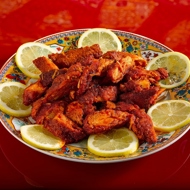
Lemon Chicken
Main Dishes • European
Description
Similarly, you can prepare skinless fish fillet, but for variety, use pomegranate juice instead of lemon juice, zest, and tomato paste for the sauce. Four tablespoons of pomegranate juice, two tablespoons of vegetable oil, three tablespoons of sugar, salt, and finally one tablespoon of cornstarch soaked in water.
Ingredients
- Skin-On Chicken Breasts 20 oz
- Lemon 1 piece
- Meyer Lemon Juice 2 tablespoons
- Sugar 2 tablespoons
- Egg white 2 pieces
- Breadcrumbs 5 oz
- Passata Tomato Sauce 2 tablespoons
- Salt 1½ teaspoons
Step-by-Step Guide
Step 1
This is a very simple yet impressive and unexpectedly delicious way to use an ordinary chicken breast from a regular supermarket with the most common ingredients.
Step 2
Cut the breast into slices about the thickness of a finger. Sprinkle them with salt.
Step 3
In one bowl, crack, salt, and whisk two eggs with a fork. In another bowl, place the breadcrumbs.
Step 4
Dip the chicken breast in the egg and coat it in breadcrumbs. Repeat the process.
Step 5
In a pan with a diameter of 15-20 cm, pour enough vegetable oil so that the breasts can float while frying. You will need about 400-500 ml of oil. Attention! The amount of oil at this stage has nothing to do with the dish we are preparing. We will fry in oil heated to 170°C. At this temperature, the moisture on the surface of the product boils instantly, and steam escapes from all possible pores that oil could enter at a different temperature. Moreover, the heated oil is the source of heat that will be transferred to the product. If there is not enough oil, the cold breast will simply cool it down, and the aforementioned effect will not occur - the oil will fill all the pores in the product, soaking it. How to determine if your oil is heated to the required temperature without a thermometer? Take small trimmings from the breast, bread them, and drop them into the oil first. Bubbles should immediately form around the piece of chicken, indicating that steam is escaping from the product and not the other way around - the oil is penetrating the product. The breading should acquire color, as in the photo, in 2-3 minutes. Larger pieces of the breast will behave exactly the same if fried one or two pieces at a time. Do not fry for too long. When raw, the breast bends if you hold it by one end. When cooked, it will not bend, and inside, at the cut, it should be pink but opaque - in a word, like in the photo. Do not worry about its doneness; it will undergo another stage of cooking. After frying the breasts, place them on paper towels to drain excess oil, and when the breasts cool slightly, cut them into pieces.
Step 6
Using a vegetable peeler, remove the zest from the lemon and cut it into thin strips. In a wok or saucepan, place two tablespoons of sugar, drizzle with one tablespoon of lemon juice, add two tablespoons of tomato paste, two tablespoons of water, and half a teaspoon of salt, and put everything on the heat.
Step 7
Stir the contents until the sugar dissolves and the mixture turns into a translucent sauce. This operation will take about three minutes. Do not worry about the amount of sugar in the sauce. It has nothing to do with the sweetness of the finished dish. When sugar is heated to 107°C in the presence of lemon juice and acid from the tomato paste, syrup inversion occurs, meaning sucrose turns into glucose and fructose. These sugars have a moderately sweet taste that will be completely balanced by the sour taste of the tomato paste. How to ensure that the syrup has heated to 107°C? You don’t need to do anything special for this. The fact is that water boils at 100°C, but the inner surface of the wok or saucepan is at a significantly higher temperature. If you do not constantly stir the quite viscous sauce, the ingredients may burn. But if you stir, the sauce temperature will be just right (you can check with a thermometer!) until the sauce begins to thicken.
Step 8
But when the sauce thickens, you should drop the pieces of chicken breast into it and stir vigorously but gently until the sauce is almost completely absorbed into the breading and chicken. In one or two minutes, the breasts will reach the necessary doneness without drying out.
Step 9
Serve on a plate with lemon slices. The zest in the sauce will give the dish a bright lemon aroma, the tomato paste and sugar together create a very pleasant sweet-sour combination, the breast remains tender and juicy, but if you don’t mention what it is, few will guess that it’s just an ordinary chicken breast. And if someone says it’s not tasty, that will be a person with a hardened and bitter heart, because a normal person cannot dislike this dish.
Cooked This Dish? Share Your Creation!
Snap a photo and let your culinary masterpiece inspire others.
Users Photos
No photos yet. Be the first to share!
